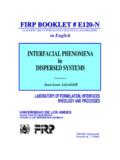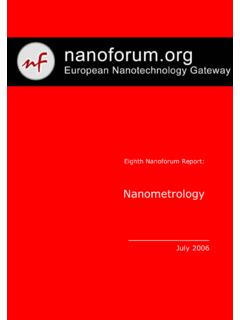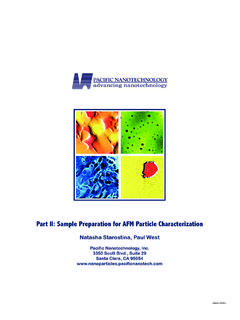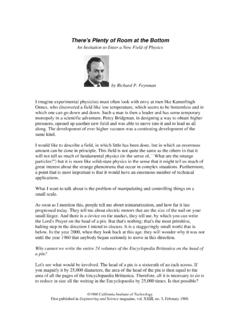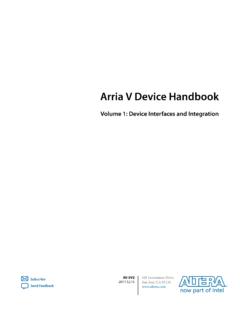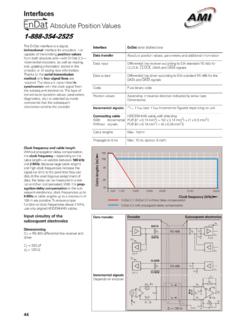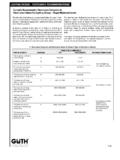Transcription of LABORATORY OF FORMULATION, INTERFACES ... - …
1 FIRP BOOKLET # E300-A. TEACHING AID IN SURFACTANT SCIENCE & ENGINEERING. in English SURFACTANTS. Types and Uses **. Jean-Louis SALAGER. LABORATORY OF formulation , INTERFACES . RHEOLOGY AND PROCESSES. UNIVERSIDAD DE LOS ANDES. FACULTAD DE INGENIERIA. ESCUELA DE INGENIERIA QUIMICA. M rida-Venezuela Versi n # 2 (2002). TABLE OF CONTENTS. 1. AMPHIPHILES and SURFACTANTS. Amphiphiles 2. Tension lowering Agent versus Surfactant 2. Classification of Surfactants 3. Production and Uses 5. 2. RAW MATIERIALS FOR SURFACTANTS. Natural Oil and Fats: Triglycerides 7. Other naturals Substances 9. Raw materials from Petroleum 11. Intermediate Chemicals 13. 3. ANIONIC SURFACTANTS. Soaps and other Carboxylates 17. Sulfonation and Sulfatation 18. Sulfates 19. Sulfonates 21. Other Anionic Surfactants 26. 4. NONIONIC SURFACTANTS. Nonionic Surfactant Types 28. Ethoxylated Alcohols and Alkylphenols 29. Fatty acid Esters 31. Nitrogenated Nonionic Surfactants 34.
2 5. CATIONIC SURFACTANTS. Linear Alkyl-amines and Alkyl-ammoniums 36. Other Cationic Surfactants 39. Nitrogenated Surfactants with a second hydrophile 40. 6. OTHER SURFACTANTS. Amphoteric Surfactants 42. Silicon Surfactants 43. Fluorinated Surfactants 44. Polymeric Surfactants or Surfactant Polymers 44. Association Polymers 47. BIBLIOGRAPHY 48. Surfactants - Types and Uses (FIRP Booklet #300A) 1. 1. AMPHIPHILES AND SURFACTANTS. AMPHIPHILES. The word amphiphile was coined by Paul Winsor 50 years ago. It comes from two Greek roots. First the prefix amphi which means "double", "from both sides", "around", as in amphitheater or amphibian. Then the root philos which expresses friendship or affinity, as in "philanthropist" (the friend of man), "hydrophilic" (compatible with water), or "philosopher" (the friend of wisdom or science). An amphiphilic substance exhibits a double affinity, which can be defined from the physico-chemical point of view as a polar-apolar duality.
3 A typical amphiphilic molecule consists of two parts: on the one hand a polar group which contents heteroatoms such as O, S, P, or N, included in functional groups such as alcohol, thiol, ether, ester, acid, sulfate, sulfonate, phosphate, amine, amide etc On the other hand, an essentially apolar group which is in general an hydrocarbon chain of the alkyl or alkylbenzene type, sometimes with halogen atoms and even a few nonionized oxygen atoms. The polar portion exhibits an strong affinity for polar solvents, particularly water, and it is often called hydrophilic part or hydrophile. The apolar part is called hydrophobe or lipophile, from Greek roots phobos (fear) and lipos (grease). The following formula shows an amphiphilic molecule which is commonly used in shapoos (sodium dodecyl sulfate). O. H3 C CH 2 CH 2 CH 2 CH 2 CH 2 CH 2 CH 2 CH 2 CH 2 CH 2 CH 2 -O-S-O- Na+. Sodium Dodecyl (ester) Sulfate. O. TENSION LOWERING AGENT versus Text: SURFACTANT.
4 SURFACTA. Because of its dual affinity, an NTS amphiphilic in molecule does not feel "at ease" in any solvent, be it polar or non polar, since there is always one of the groups which "does not like" the AQUEOUS. solvent environment. This is why amphiphilicSOLUTION molecules exhibit a very strong tendency to migrate to INTERFACES or surfaces and to Author: orientate so that the polar group lies in water and the apolar group is placed out of it, and eventually in oil. Jean-Louis In the following the word surface SALAGER. will be used to designate the limit between a condensed phase and a gas phase, whereas the termReference: interface will be used for the boundary between two condensed phases. This distinction is handy FIRP though Bookletnot necessary, and the two words are often used indifferently particularly in american#terminology. 201. Version # 1. In English the term surfactant (short for surface-active-agent) designates a substance (01/30/1993).
5 Which exhibits some superficial o interfacial TranslationIt is worth remarking that all amhiphiles do activity. not display such activity; in effect, only the amphiphiles with more or less equilibrated (06/15/1994). hydrophilic and lipophilic tendencies are Edited likely toand migrate to the surface or interface . It does not happen if the amphiphilic molecule is toopublished hydrophilic or too hydrophobic, in which case it stays by: in one of the phases. Surfactants - Types and Uses (FIRP Booklet #300A) 2. In other languages such as French, German or Spanish the word "surfactant" does not exist, and the actual term used to describe these substances is based on their properties to lower the surface or interface tension, tensioactif (French), tenside (German), tensioactivo (Spanish). This would imply that surface activity is strictly equivalent to tension lowering, which is not absolutely general, although it is true in many cases.
6 Amphiphiles exhibit other properties than tension lowering and this is why they are often labeled according to their main use such as: soap, detergent, wetting agent, disperssant, emulsifier, foaming agent, bactericide, corrosion inhibitor, antistatic agent, etc In some cases they are konwn from the name of the structure they are able to build, membrane, microemulsion, liquid crystal, liposome, vesicle or gel. CLASSIFICATION OF SURFACTANTS. From the commercial point of view surfactants are often classified according to their use. However, this is not very useful because many surfactants have several uses, and confusions may arise from that. The most acepted and scientifically sound classification of surfactants is based on their dissociation in water. The figures in page 4 show a few typical examples of each class. Anionic Surfactants are dissociated in water in an amphiphilic anion*, and a cation*, which is in general an alcaline metal (Na+, K+) or a quaternary ammonium.
7 They are the most commonly used surfactants. They include alkylbenzene sulfonates (detergents), (fatty acid). soaps, lauryl sulfate (foaming agent), di-alkyl sulfosuccinate (wetting agent), lignosulfonates (dispersants) etc Anionic surfactants account for about 50 % of the world production. Nonionic Surfactants come as a close second with about 45% of the overall industrial production. They do not ionize in aqueous solution, because their hydrophilic group is of a non- dissociable type, such as alcohol, phenol, ether, ester, or amide. A large proportion of these nonionic surfactants are made hydrophilic by the presence of a polyethylene glycol chain, obtained by the polycondensation of ethylene oxide. They are called polyethoxylated nonionics. In the past decade glucoside (sugar based) head groups, have been introduced in the market, because of their low toxicity. As far as the lipophilic group is concerned, it is often of the alkyl or alkylbenzene type, the former coming from fatty acids of natural origin.
8 The polycondensation of propylene oxide produce a polyether which (in oposition to polyethylene oxide) is slightly hydrophobic. This polyether chain is used as the lipophilic group in the so-called polyEO- polyPO block copolymers, which are most often included in a different class, polymeric surfactants, to be dealt with later. Cationic Surfactants are dissociated in water into an amphiphilic cation and an anion, most often of the halogen type. A very large proportion of this class corresponds to nitrogen compounds such as fatty amine salts and quaternary ammoniums, with one or several long chain of the alkyl type, often coming from natural fatty acids. These surfactants are in general more * Anion: negatively (-) charged ion which moves toward anode during electrolysis. * Cation: positively (+) charged ion which moves toward cathode. Surfactants - Types and Uses (FIRP Booklet #300A) 3. expensive than anionics, because of a the high pressure hydrogenation reaction to be carried out during their synthesis.
9 As a consequence, they are only used in two cases in which there is no cheaper substitute, (1) as bactericide, (2) as positively charged substance which is able to adsorb on negatively charged substrates to produce antistatic and hydrophobant effect, often of great commercial importance such as in corrosion inhibition. When a single surfactant molecule exhibit both anionic and cationic dissociations it is called amphoteric or zwitterionic. This is the case of synthetic products like betaines or sulfobetaines and natural substances such as aminoacids and phospholipids. O H3 C COO. C 12 H 25 -S-O - Na+ H. O Abietic Acid Sodium Dodecyl BenzeneSulfonate sodium CH 3. H3 C O. P-C14 H 29 CH(CH 3 ). 2. H3 C O. O. Dimethyl Ether of Tetradecyl Phosphonic C 8 H 17 O CH 2-CH 2 -O H. Acid n C11H29 -C-N-CH 2-CH 2 Polyethoxylated Octyl Phenol -OH OH. Lauryl Mono-Ethanol CH 2OH. Amide O O. CH 2-OOC-R' R-C-O OH. CH-OH. HO OH. CH 2.
10 -OOC-R" Sorbitan Monoester Glycerol Diester (diglyceride). C12H25. - N-H + Cl N. C12H25. CH 2-CH 2 -COOH. Dodecyl Betaine N-Dodecyl Piridinium Chloride A few commonly used surfactants Surfactants - Types and Uses (FIRP Booklet #300A) 4. Some amphoteric surfactants are insensitive to pH, whereas others are cationic at low pH. and anionic at high pH, with an amphoteric behavior at intermediate pH. Amphoteric surfactants are generally quite expensive, and consequently, their use is limited to very special applications such as cosmetics where their high biological compatibility and low toxicity is of primary importance. The past two decades have seen the introduction of a new class of surface active substance, so-called polymeric surfactants or surface active polymers, which result from the association of one or several macromolecular structures exhibiting hydrophilic and lipophilic characters, either as separated blocks or as grafts.
